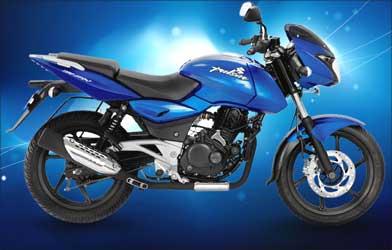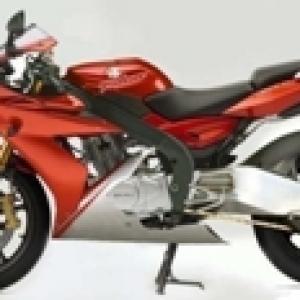Ever wondered the reasons behind the huge success of Baja Auto's Pulsar range of bikes? Currently Bajaj sells around 60,000 units per month. Overwhelmed by the demand Bajaj is now planning to increase the production capacity of its Chakan plant to 90,000 units.
 What is the secret behind Pulsar's popularity? Most young bikers prefer this because of its sporty looks and technology. The versions of the model currently available in the Indian market include Pulsar 135 LS, Pulsar 150 TDS-i, Pulsar 180 TDS-i and Pulsar 220 TDS-i.
What is the secret behind Pulsar's popularity? Most young bikers prefer this because of its sporty looks and technology. The versions of the model currently available in the Indian market include Pulsar 135 LS, Pulsar 150 TDS-i, Pulsar 180 TDS-i and Pulsar 220 TDS-i.
The bike is the market leader in the 150 cc segment with a market share of 43 per cent. Expecting a surge in demand, Bajaj has set up sales target of one million units of Pulsar for FY 2011.
Developed by Bajaj Auto in association with designer Glynn Kerr Tokyo R&D, Pulsar was first launched on November 24, 2001. At that time, the Indian two-wheeler industry was populated by 80-100cc bikes with less power capacity. Bajaj had expected Pulsar to attract young power biking lovers of the country. The whole project cost Rs 100 crore (Rs 1 billion).
The original Pulsar was equipped with a 150 cc engine. The petrol bike had spark-ignited four-stroke engine with air-cooled, single-cylinder. The bike, with wheelbase of 1,235 mm, had simple spring shock absorbers and round headlamp dome.
Parking lights and an aircraft-type fuel tank lid were other features of the bike. Bajaj later came up with 180 cc version of Pulsar. The bike was also offered in electric start option.
Bajaj Auto offered the second generation of Pulsar with its patented DTSi technology. DTSi stands for Digital Twin Spark Ignition, and it involves usage of two spark plugs (instead of one) per engine cylinder. It helped in both increasing power and saving fuel for the bike.
Bajaj Auto launched a new version of Pulsar with 17-inch alloy wheels as standard option in 2005. The new bike had fuel tank capacity of only 15 litres, but the power output was increased to 13.5 bhp (10.1 kW) @ 8500 rpm for the 150 cc version while it was increased to 16.5 bhp (12.3 kW) @ 8500 rpm for the 180 cc model.
Bajaj re-launched Pulsar with some new features in 2006. The new features included pilot lamps separated from the main headlamp, flush LCD screen with digital read-out of key vehicle data, non-contact speed sensor and non-contact backlit switches.
Bajaj showcased fuel injected model Pulsar 220 DTS-Fi at the New Delhi Auto Expo in 2006, and later launched it in 2007. The model was later replaced by Pulsar 220 DTS-i in 2009. Bajaj Auto launched a carbureted version of Pulsar 220 in June 2009, and billed it as "The fastest bike in India". The company discontinued Pulsar 200 in July 2009.
The company launched Pulsar 135LS, a 134.66 cc bike, in December 2009. The bike was a huge hit with young bike buyers. It became the 2nd largest bike in the performance segment within 100 days of its launch with monthly sales of around 25,000 units. Pulsar 150 TDS-i is the best selling bike in the performance segment with sales of around 26,000 unit sales per month.
Pulsar 150 TDS-i is equipped with 149.01cc air-cooled petrol engine with five speed manual transmission gearbox that produces 14.09PS of maximum power and 12.76Nm of maximum torque. The 180cc model of Pulsar is powered by 178.6cc, 4-stroke petrol engine that produces maximum power of 17.02PS and maximum torque of 14.22Nm.
On the other hand, the 220cc Pulsar has air-cooled and oil-cooled petrol engine that delivers 21.04PS of power and 19.12Nm of torque.
Pulsar has been awarded several times since its launch in 2001. The awards include "Bike of the Year" by CNBC-TV18 Autocar in 2007, "Viewers' Choice Two Wheeler of Year" by BBC World Wheels Award in 2003 and "Most Exciting Bike of the Year" by Overdrive magazine in 2002.







